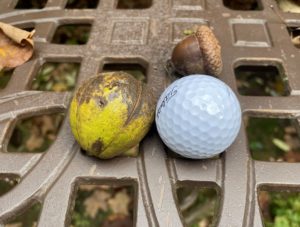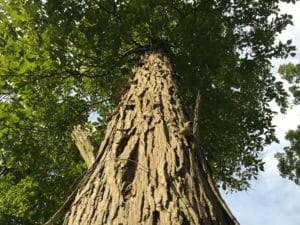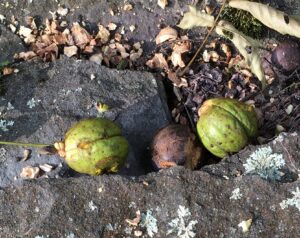Hello, Fellow Readers, These are nutty times. Far nuttier than usual in my neck of the woods. The Shagbark Hickory nuts are overabundant and golf ball and size, so much so that walking amongst them is risky for ankle stability. It’s called masting when there’s an excess of nuts, but how do trees know when to dial up the volume in mast years?
A few years ago, I had the privilege of attending Dr. Doug Tallamy’s talk about his book The Nature of Oaks, which I highly recommend. He spoke about why there aren’t the same number of nuts each year, Mother Nature’s way of checks and balances of controlling populations, called predator satiation.
Nature’s way of controlling populations
In a nutshell, (I couldn’t resist) the hypothesis is same species of plants simultaneously produce more seeds or nuts than can be consumed by animals so that the plant will have plentiful seeds and nuts to reproduce. And other years, when there are only a few or no nuts, squirrels, chipmunks, blue Jays, turkeys, etc., may starve, keeping populations in check.

A Beyond Nutty Mast Year
Large oaks can produce 10,000 acorns in a mast year – 10 to 20 times more than average, and trees grow more slowly when masting as they put energy into making nuts.
We’ve all heard the folklore that an abundance of nuts means a severe winter ahead, right up there with a theory that the narrower the brown band on woolly bear caterpillars, the harsher the winter, but neither is scientifically proven.
Trees grow more slowly during the Mast Years.
Scientists aren’t precisely sure what causes mast years, though theories of environmental reasons, available pollen, and chemical signaling are likely. Certainly, untimely spring freezes can kill fruit-bearing buds, and wet and cold springs can impact pollination, just as dry, hot summers influence the size of fruits and nuts. But, the specific triggers for mast years, which occur every two to five years, are not definitive.
My adored Shagbark Hickories (Carya ovata) are native trees. Its common name speaks for itself with a shaggy bark that stands out like a sculpture. But a treasure to some can be a nuisance to others. It’s true the first time a golf ball-sized nut thumped my head, it was a stinging surprise. Then there’s the feeling of walking on marbles during the fall nut drop.
Still, I’m glad the bear, fox, rabbits, squirrels, raccoons, and turkeys enjoy the nuts before tackling the cleanup, making the task far lighter to manage. Jolee also loves the nuts, which is becoming an afternoon feast. That is after she chases the squirrels, her favorite sport. While I have not tried them, I heard that the nuts taste very similar to pecans, which are also in the walnut family.

Shagbark Hickory
Shagbark Hickories as a Shade Tree
I never had a client request planting a Shagbark Hickory as a shade tree until this week when new clients in Morristown suggested we install a Shagbark Hickory rather than the planned Red Oak, the New Jersey State tree. They said the Shagbark Hickory would pollinate the Pecan tree as they are from the same family. Mother Nature is so clever.
Shagbark Hickory produces juglone, a natural herbicide. Still, in far less concentration than Eastern Black Walnut, so as far as I know, there are no plants to avoid around Shagbark Hickory.
The cycle of Shagbark Hickory Nuts

Shagbark Hickory Nuts- Before Squirrels
Once Shagbark Hickory trees are old enough to bear fruit, they will produce nuts in three-year cycles. In the first year of that cycle, the tree will yield a massive bounty, as many as 18 gallons of nuts – almost four 5-gallon buckets full from a single tree. Then, there will be about 10 gallons in year two, and in year three, the tree will be nutless. No wonder leaf cleanup didn’t come with the usual wheelbarrows full of nut-raking last year.
The cycles of nature, the unique ways things unfold, and how nature keeps things in balance are miraculous if we don’t mess things up. And while we may feel small compared to the whole world, we can play a significant role in helping each other and helping nature. It’s about being kind.
Garden Dilemmas? AskMaryStone@gmail.com and your favorite Podcast App.
There’s much more in the Garden Dilemmas Podcast, including a story of a fellow gathering Black Walnuts along the road to help wildlife:
Related Stories (and Podcast Episodes) and Helpful Links:
Fruits and Veggies near Black Walnut
More about Dr. Doug Tallamy’s talk – Native Plants, especially Oaks, are Essential, and his book Nature of Oaks
Related Podcast Ep 32. Juglone Companions, Fascinating Fasciation



I have enjoyed Hickory nuts since I was a small child. I am from a family of 7 children. We played outside a lot. A favorite pastime was cracking and eating hickory nuts. Now 59 years old I re discovered my love for hickory nuts. Easing into retirement, I realize I need some healthy outdoor activities. Hunting for hickory trees is my latest obsession. My older sister Karen recently told me she remembers that hickory nut tree. She announced this when I gave her a taste of a hickory nut. It was a flavor inspired memory. She tasted that nut and instantly recalled that huge shagbark hickory in back of our house in Seneca Knolls, NY. I watched her upload map quest on my phone and punched in the address of our old house. There on the screen was the hickory tree, my old friend, sitting in the field.
Hello Paul, Such fun to read about your long history with Hickory Nuts. And that your beloved tree still stands!
Thank you for sharing and for reading my column, Mary Stone